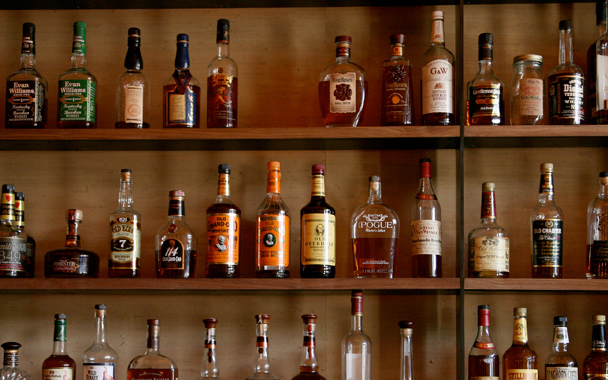The wine list at Char No. 4, a new restaurant in Brooklyn, is fabulous: Darting Riesling from Germany’s Pfalz region and Roagna Dolcetto from Alba, both by the glass; a small but smartly chosen selection of half bottles like Robert Sinskey’s Carneros Pinot Blanc or Pibaron Bandol; and a full-bottle list that reads like a compilation of the world’s best undersung wines—and tops out at $78.
Yet despite those temptations, all I wanted was whiskey. The place is steeped in it, from the wall of bottles behind the bar to the whiskey-barrel-shaped lights overhead that throw a warm bourbon glow. The place even smells of it—although that might be the scent of the bacon and smoke emanating from the kitchen, too. While you could order a bottle of wine and be quite happy, it feels like that would be missing the point. Someone here loves whiskey, and loves it deeply, from the corn liquor more commonly referred to as moonshine to $200-an-ounce Scottish pours.
The whiskey freak, as it turns out, is co-owner Michael Tsoumpas. His partner, Sean Josephs, who mans the front of the house and the wine list, told us, “Michael said he really didn’t care what sort of restaurant we opened. He just wanted to do something with a lot of whiskey.”
Josephs seems to harbor no jealously toward the spirit that steals the show from his wine list—if anything, he’s embraced it. Asked how to maneuver through the 300-some offerings by a clueless wine geek (me), he advised deciding first whether to go American or imported. “It’s essentially a New World–Old World difference, like in wine,” he explained. The climate of the British Isles is far cooler than that of America’s South, so its whiskies age more slowly. Also, American whiskeys tend to go into new, well-charred American oak barrels that add deep, toasty vanilla tones.
That sounds a lot like the general difference between, say, California Chardonnay (warm climate, toasty American oak) and Burgundy (cold climate, neutral French oak). So I went with the “what grows together goes together” rule that often works with wine, and, knowing there was a Texan in the kitchen and Joseph’s New Orleanian wife, Mani, had some influence on the menu, went American.
That still meant choosing between “Traditional Mashbill Bourbon,” Tennessee whiskey, corn whiskey, wheated Bourbon and Rye (never mind the array of uncategorizable bottles). Joseph started us off easy, with an Elijah Craig 12-year-old bourbon and a Rittenhouse rye—two of the cheapest on the list at $6 a glass—but, he said, very representative of the genres.
Dipping deep-fried cheese curds in creamy pimiento sauce, it was hard to imagine a better match than the brown-sugar sweetness of the bourbon with its peppery alcoholic kick. It handily took on the chopped pork sandwich as well, though the rye’s bitter, earthy edge gave it the advantage when it came to the fat, juicy house-smoked sausage and German potato salad. Perhaps a smoky Syrah or a bright, sharp Riesling would have been just as pleasurable, but, at the moment, in a dark dining room redolent of bacon, apples, smoke, and spice, nothing could have felt as perfect as a tumbler of the brown stuff.
Char No. 4 196 Smith St., Brooklyn, NY (718-643-2106)



 Pinterest
Pinterest


